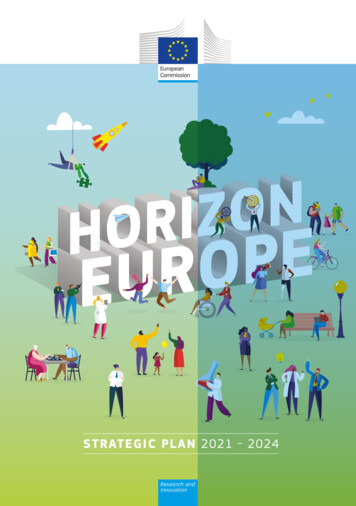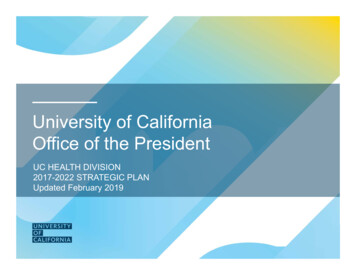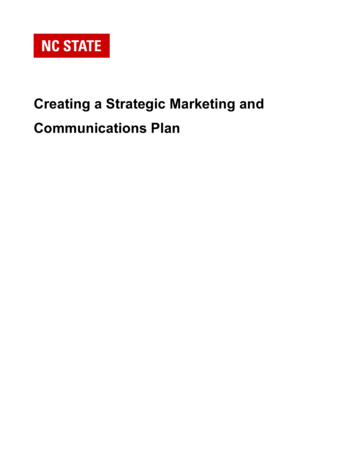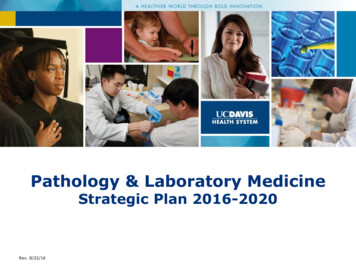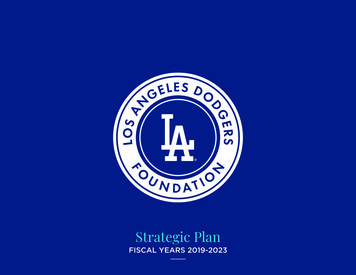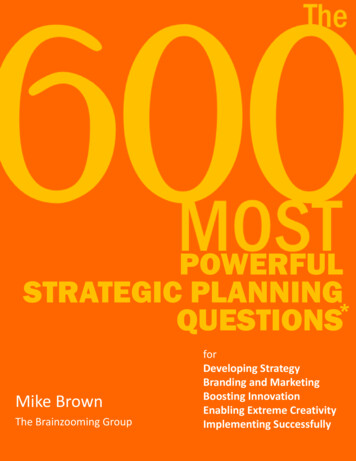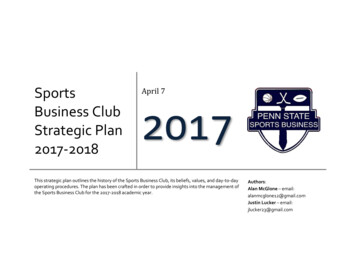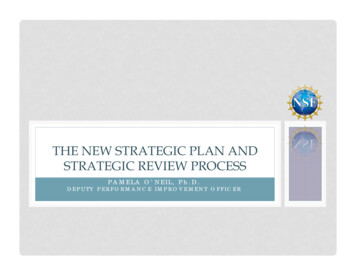
Transcription
THE NEW STRATEGIC PLAN ANDSTRATEGIC REVIEW PROCESSPAMELA O’NEIL, Ph.D.DEPUTY PERFORMANCE IMPROVEMENT OFFICER
http://www.nsf.gov/publications/pub summ.jsp?ods key nsf14043
HOW WILL THE PLAN BE USED? Communication Program and budget planning Accountability in staff performance plans GPRA Modernization Act of 2010 and OMB A-11 Performance.gov (new) Strategic Reviews (new) Performance reporting3
HIGH LEVEL CONTENT: MISSION – The NSF Act of 1950 (Public Law 81-507) setsforth a mission: “to promote the progress of science; toadvance the national health, prosperity, and welfare; tosecure the national defense; and for other purposes.” VISION: A nation that creates and exploits new conceptsin science and engineering and provides globalleadership in research and education Core Values Scientific Excellence Organizational Excellence Learning Inclusiveness Accountability for Public Benefit4
CORE STRATEGIES Envision the future of science and engineering throughthe eyes of the world’s front-line researchers. Maintain a balanced portfolio that provides opportunities for research in all fields of S&E. Maintain a balanced portfolio with regard to themechanisms of support. Selectively invest in targeted areas of research relatedto high priority societal needs. Foster the development of fundamental research andinnovation. Integrate research and education to equip the continuous flow of STEM graduates with the latest ideas, technological know-how, and networksof contacts. Ensure diversity is at the forefront of all of NSF’s internal and external activities to develop the Nation’s intellectual potential. Maintain the public’s trust by operating withtransparency, accountability, integrity, and ethicalconduct. Maintain NSF’s reputation as the gold standard of meritreview, while welcoming constructive criticism andseeking continuous improvement.
STRATEGIC GOALSStrategic Goal 1: Transform the Frontiers ofScience and Engineering.Strategic Goal 2: Stimulate Innovation andAddress Societal Needs through Research andEducation.Strategic Goal 3: Excel as a Scientific FederalAgency.
Strategic Goal 1: Transform the Frontiers ofScience and Engineering. Strategic Objective G1/O1: Invest infundamental research to ensure a continuingstream of advances across NSF science,engineering, and education. Strategic Objective G1/O2: Integrate educationand research to produce a diverse STEMworkforce with cutting-edge capabilities. Strategic Objective G1/O3: Provide world-classresearch infrastructure to enable majorscientific advances.
Strategic Goal 2: Stimulate Innovation andAddress Societal Needs through Research andEducation. Strategic Objective G2/O1: Strengthen the linksbetween foundational research and societalneeds through investments and partnerships. Strategic Objective G2/O2: Build the capacityof the Nation to address societal challengesusing a suite of formal, informal, and broadlyavailable STEM educational mechanisms.
Strategic Goal 3: Excel as a ScientificFederal Agency. Strategic Objective G3/O1: Build anincreasingly diverse, engaged, and highperforming NSF workforce by fosteringexcellence in recruitment, training, leadership,and management of human capital. Strategic Objective G3/O2: Use effectivebusiness methods and innovative solutions toachieve excellence in accomplishing theagency’s mission.
STRATEGIC REVIEW DEFINITION:A PROCESS BY WHICH FEDERAL AGENCIES WILL ANNUALLY ASSESS PERFORMANCE ONTHE STRATEGIC OBJECTIVES IN THE STRATEGIC PLAN TO IDENTIFY AREAS FORIMPROVEMENT.Additional detail: A process involving the highest level of leadership at theagency that uses evidence and data to answer key analyticalquestions. The process informs strategy and budget formulation, identifiesopportunities for improvement and “significant challenges” tobe reported to OMB. Internal stakeholders are the audience for the process. OMB is the audience for the final summary of findings.
AD or DAD will leadStrategic Review Team: Lieutenant Program staff Science Assistant Others?Ex-officio Work Team: Deputy PIO BD data experts Evaluation expert (OIIA) External supportTeam will formulate acarefully defined set ofkey analytical questions: Is our strategy effective? Are we executingefficiently? Do we have adequatecapabilities, resources, andsupport? Did we achieve ourexpected outputs? Are the projects that wefunded on track? What do externalevaluations that have beenconducted tell us aboutimpact? What evaluations should bedone in the future?Strategic Review:A processby which federal agencies will annuallyassess performance on the strategicobjectives in the Strategic Plan toidentify areas for improvement.Lieutenant will work withstaff to use data toanswer key questions. Program staff, with the help ofPerformance Staff in BD, EvaluationOffice in OIIA, and expert supportcontracted through BD.Team will preparea brief report toPIO and COO.A Summary of Findingswill be presented atSMART.Optional: Interestingresults can becommunicated to NSFstaff broadly using a forumsuch as a debate or aTownhall.
Director’s ReviewBoardNational ScienceBoard MeritReview ofProposalsAnnual ProjectReportsSite VisitsFinal ProjectReportExternalformative orsummativeevaluation Project-levelevaluationsinitiated byawardees.Monitoring SystemsExternal EvaluationAssessment/ExpertStudy ce andPriority GoalsMerit ReviewReportStrategic Reviews Assessmentof NSFProcesses ,outputs, oroutcomes.Science of SciencePolicy Studies thatexamine thevalue ofsciencefunding.ScienceProgram OfficerReview AnalysisNSFSite VisitsNSF ProgramPanel ReviewNSF-Funded ProjectAd hoc ReviewProposalOVERVIEW OF ASSESSMENTMECHANISMS AT NSF
HOW WILL THE RESULTS BE USED?Cross-cutting Analysis (Conducted by PIOs with input fromPolicy and Budget Offices) Analyze relative impact on agency mission and prioritiesacross objectives Determine objectives with Noteworthy Progress/SignificantChallenges Identify improvement actions, including possible changesto strategy, budget, or operational changesDecisions (made by COO with support from PIO) Make decisions on proposals for the budget andperformance submission to OMB, and appropriate materialfor public reporting Identify immediate actions which can be taken by theagency
PROCESS TIMELINE – ANNUAL CYCLE Strategic Review processreviewed with senior leadership.Strategic Review leaderscharged and teamsestablished. Strategic review teams gatherevidence to answer keyanalytical Questions. Summary of findings for eachStrategic Objective Presentedto SMART. PIO and CIO review findingsand recommendations. Initial findings submitted toOMB on May 16th. Specific actions discussed bysenior management in budgetplanningQ2Q1FY 2014FY 20.Q3Q4FY 2014FY 2014 SeniorManagementengaged inidentifying keydirections forStrategicReviews. Findings fromstrategic reviewsused in budgetformulation anddevelopment ofPerformance Plan.
PROCESS TIMELINE – SENIORMANAGEMENT INVOLVEMENT Strategic Review processreviewed with senior leadership.Strategic Review leaderscharged and teamsestablished. Strategic review teams gatherevidence to answer keyanalytical Questions. Summary of findings for eachStrategic Objective Presentedto SMART. PIO and CIO review findingsand recommendations. Initial findings submitted toOMB on May 16th. Specific actions discussed bysenior management in budgetplanningQ2Q1FY 2014FY 20.Q3Q4FY 2014FY 2014 SeniorManagementengaged inidentifying keydirections forStrategicReviews. Findings fromstrategic reviewsused in budgetformulation anddevelopment ofPerformance Plan.
Goal 1: Transform the Frontiers of Science and Engineering.Objective 1. Invest in fundamental research to ensure a continuous stream of advances across NSF science,engineering, and g forprogram or set ofprogramsFundingcompetitionsthrough DCLS,Solicitations, andProgramannouncementsFunded ProjectsKnowledge andexpertise of NSFworkforceSHORT‐TERMNSF funding hasresulted in aportfolio ofprojects that areconductingresearch andmaking progressMerit mesQuality, Use & SatisfactionEffectivenessFormative evaluationAre we doing the “right” work?1Are we doing the work “right”?Summative evaluationHave we funded the “right” portfolio?235The portfolio ofprojects hasresulted insignificantoutcomes ormeasureableimpactEstablishedresearch projecthas producedoutputs, hastrained students,and providedresults for newNSF proposalsRelationships & CapacityIMPACTWhat have we learned that willhelp us improve?What difference have we made?4
KEY ANALYTICAL QUESTIONS FOR STRATEGIC OBJECTIVE G1/O1:INVEST IN FUNDAMENTAL RESEARCH TO ENSURE A CONTINUINGSTREAM OF ADVANCES ACROSS NSF SCIENCE, ENGINEERING, ANDEDUCATION.Q1 Does NSF have adequate mechanisms to fundIDR and PTR?H0 ExistingNSF coreprogramsprovideappropriatereview ofIDR and PTRproposals.H1 Somecuttingedge IDR orPTRproposalsdo not fit inexisting NSFprograms.H2 SpecialIDR or PTRprograms(like INSPIRE)are neededto provide ahome forIDR and PTR.H3 All NSFprogramsencourageIDR and PTRproposals.Q2 Does funding forNSF-wide activitiesimpact coreprograms?H1 NSF-wideactivitiesarebudgetbuilders.H2 NSF-wideactivitiessupportcoreresearch.
KEY ANALYTICAL QUESTIONS FOR STRATEGIC OBJECTIVE G2/O1:STRENGTHEN THE LINKS BETWEEN FOUNDATIONAL RESEARCHAND SOCIETAL NEEDS THROUGH INVESTMENTS ANDPARTNERSHIPS.Focus: Linking knowledge and practiceWhat is the currentconventional wisdomfor knowledgetransfer? (what areother agencies,universities, theprivate sectordoing?)What are the variousmodels, tools, andmechanismsavailable within NSF?How are they tunedto past and currentsocietal needs?What does NSF needto do to adapt newways of linkingknowledge andpractice? What arethe gaps in what isneeded and what weare currently doing?
STRATEGIC OBJECTIVE G3/O2: USE EFFECTIVE BUSINESSMETHODS AND INNOVATIVE SOLUTIONS TO ACHIEVEEXCELLENCE IN ACCOMPLISHING THE AGENCY’S MISSION.What effect does NSF culture have on our ability to useeffective business methods and innovative solutions toachieve excellence in accomplishing the Agency’s mission?What can organizational theory tellus about the strengths andweaknesses of our structure andculture?What can welearn from otheragency’s or theprivate sector?Are thereexamples ofsimilarorganizationsthat achieveorganizationalexcellence?Does NSF’s distributed-managementmodel affect the efficiency of NSFwide processes?Is thereevidence thatbusinessprocesses canbe improved bychanging ourculture?Is thereevidence thatour culture resultsin efficiency orinefficiency?Do someorganizationalunits at NSF haveprocesses thatshould beemulated?Does our lack ofconformity makeus flexible orrecalcitrant?
A Summary of Findings will be presented at SMART. Optional: Interesting results can be communicated to NSF staff broadly using a forum such as a debate or a Townhall. Strategic Review: A process by which federal agencies will annually assess performance on the strategic objectives in the Strategic Plan to identify areas for improvement.



